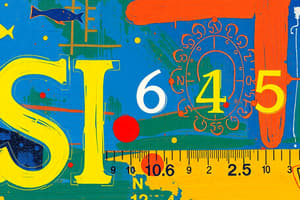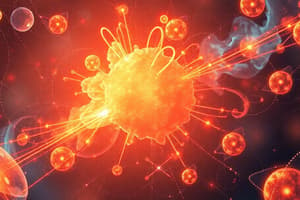Podcast
Questions and Answers
What is the correct symbol for a unit named after the scientist Isaac Newton?
What is the correct symbol for a unit named after the scientist Isaac Newton?
- No
- nE
- N (correct)
- n
Which of the following units is written in lowercase letters?
Which of the following units is written in lowercase letters?
- Kilogram
- Meter (correct)
- Coulomb
- Ampere
How should the unit symbol and the numeral be spaced?
How should the unit symbol and the numeral be spaced?
- No space should be left between them.
- Two spaces should be left.
- The numeral should follow immediately.
- One space should be left. (correct)
Which of the following is incorrect regarding the plural forms of units?
Which of the following is incorrect regarding the plural forms of units?
Which of these statements correctly describes how to format unit symbols?
Which of these statements correctly describes how to format unit symbols?
What is the correct symbol for the unit of electric current, Ampere?
What is the correct symbol for the unit of electric current, Ampere?
What is the fundamental length unit in the CGS system of units?
What is the fundamental length unit in the CGS system of units?
Which of the following systems of units is known as the British system?
Which of the following systems of units is known as the British system?
In the International System of Units (SI), which unit represents time?
In the International System of Units (SI), which unit represents time?
Which of the following stated rules is correct for writing SI units?
Which of the following stated rules is correct for writing SI units?
Which of the following is NOT a fundamental unit in the SI system?
Which of the following is NOT a fundamental unit in the SI system?
What are the fundamental units in the MKS system of units?
What are the fundamental units in the MKS system of units?
Which characteristic of units ensures that they can be replicated in any measurement?
Which characteristic of units ensures that they can be replicated in any measurement?
How many fundamental units are included in the SI unit system?
How many fundamental units are included in the SI unit system?
Which SI prefix corresponds to a factor of $10^{-3}$?
Which SI prefix corresponds to a factor of $10^{-3}$?
What is the SI unit for length based on the meter?
What is the SI unit for length based on the meter?
In the MKS system, which of the following units is incorrect?
In the MKS system, which of the following units is incorrect?
Which of the following is NOT an SI unit for measuring time?
Which of the following is NOT an SI unit for measuring time?
How many picometers are in a meter?
How many picometers are in a meter?
What is the primary use of the astronomical unit?
What is the primary use of the astronomical unit?
According to the SI rules, how should units be written in terms of capitalization?
According to the SI rules, how should units be written in terms of capitalization?
Which of the following describes the FPS system of units?
Which of the following describes the FPS system of units?
Flashcards are hidden until you start studying
Study Notes
Rules for Writing SI Units
- Symbols for units named after scientists are capitalized: N for Newton, A for Ampere, K for Kelvin, C for Coulomb.
- All other unit symbols are in lowercase: m for meter, kg for kilogram, s for second, cd for candela.
- Leave one space between numerals and unit symbols, e.g., 10 kg, 5 N.
- Units do not have plural forms: 6 meter is correct, not 6 meters.
- No space between symbols for combined units, e.g., 4 J/s is correct, not 4 J s.
Characteristics of Units
- Units must be well-defined, suitable in size, reproducible, invariable, indestructible, and internationally accepted.
Systems of Units
- CGS System: Introduced in France, based on centimeter, gram, and second.
- MKS System: Also French, using meter, kilogram, and second as fundamental units.
- FPS System: British system based on foot, pound, and second.
- SI System: Established in 1971, includes seven fundamental and two supplementary units.
Fundamental Units of SI
- Length: metre (m)
- Mass: kilogram (kg)
- Time: second (s)
- Temperature: kelvin (K)
- Electric current: ampere (A)
- Luminous intensity: candela (cd)
- Amount of substance: mole (mol)
SI Prefixes
- Prefixes indicate factors of ten, e.g., kilo (k) for 10^3, milli (m) for 10^-3, giga (G) for 10^9, and nano (n) for 10^-9.
Practical Examples of SI Units
- Example conversions using prefixes:
- 3 milliampere = 3 mA = 3 × 10^-3 A
- 5 microvolt = 5 μV = 5 × 10^-6 V
- 8 nanosecond = 8 ns = 8 × 10^-9 s
- 6 picometre = 6 pm = 6 × 10^-12 m
Practical Units for Measuring Length
- 1 micron = 1 x 10^-6 m (used for bacteria).
- 1 nanometer = 1 x 10^-9 m (used for molecules).
- Astronomical Unit: The mean distance of the Earth from the Sun, approximately 1.496 x 10^11 m.
- Light Year: Distance light travels in one year, approximately 9.461 x 10^15 m.
Practical Units for Measuring Time
- 1 Solar day = 24 hours.
- 1 Sidereal day = 23 hours 56 minutes.
- 1 Solar year = 365 solar days = 366 sidereal days.
- 1 Lunar month = 27.3 solar days.
- 1 shake = 10^-8 seconds.
Example Conversions
- 10 meters to inches.
- Speed in km/h to cm/s conversion.
- 1 kilometer to yards conversion.
- 18 kg to slugs.
- 432 to base conversion.
- 18.94 liters to gallons.
- 264 ft/s to miles per hour.
- Height conversion from feet to centimeters.
Studying That Suits You
Use AI to generate personalized quizzes and flashcards to suit your learning preferences.



